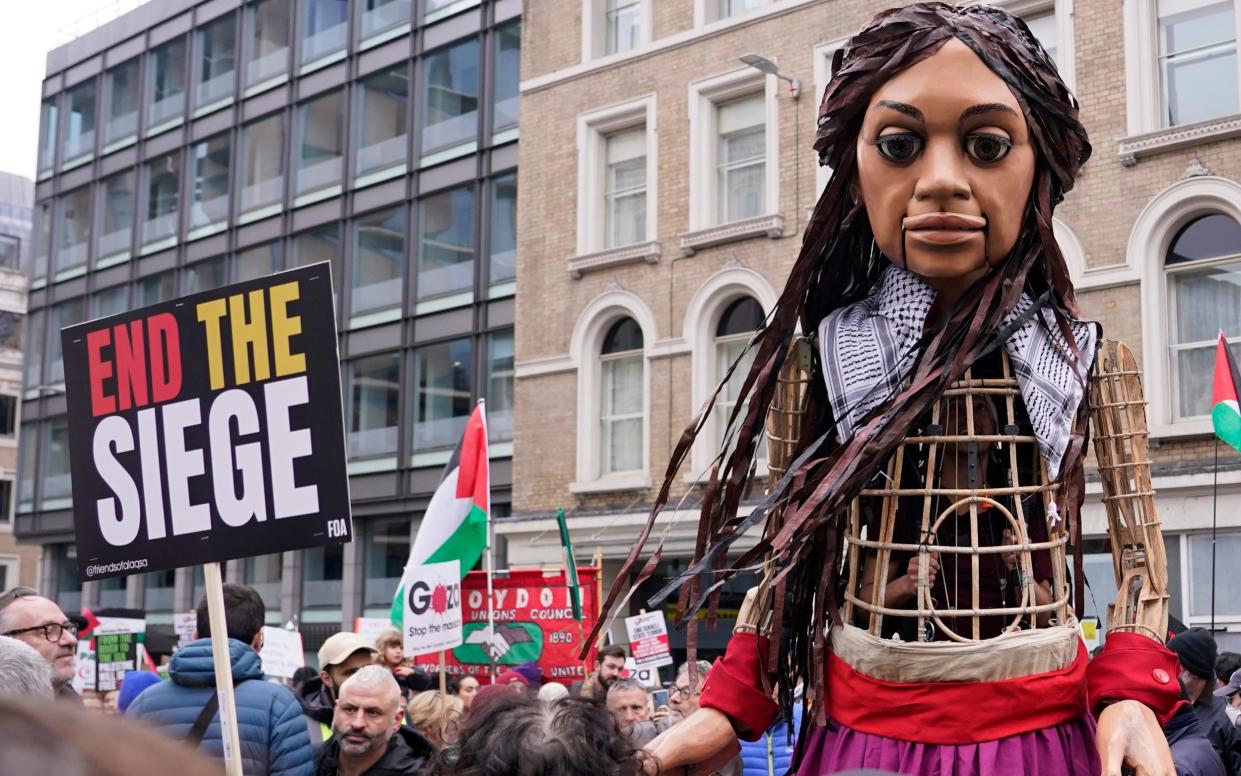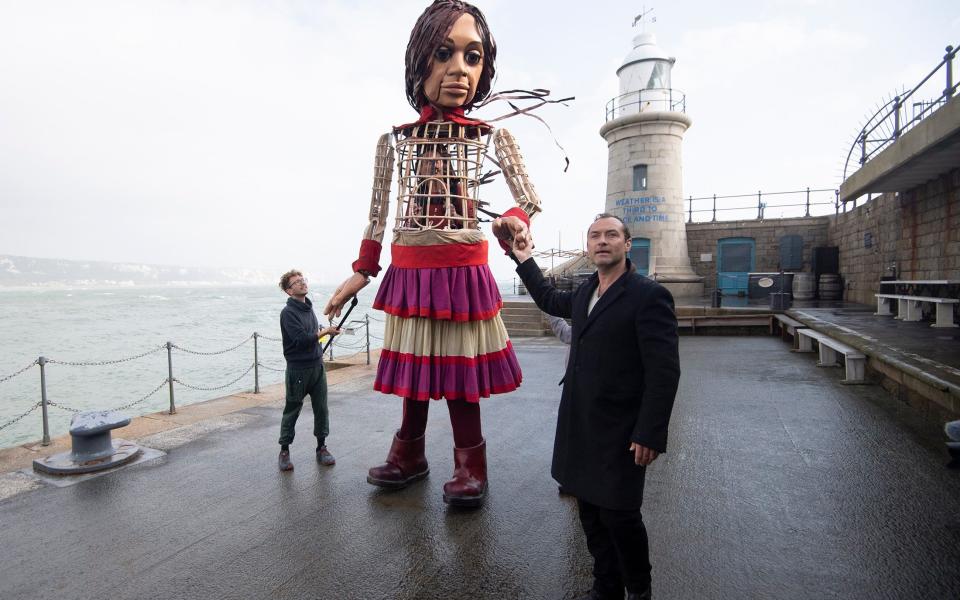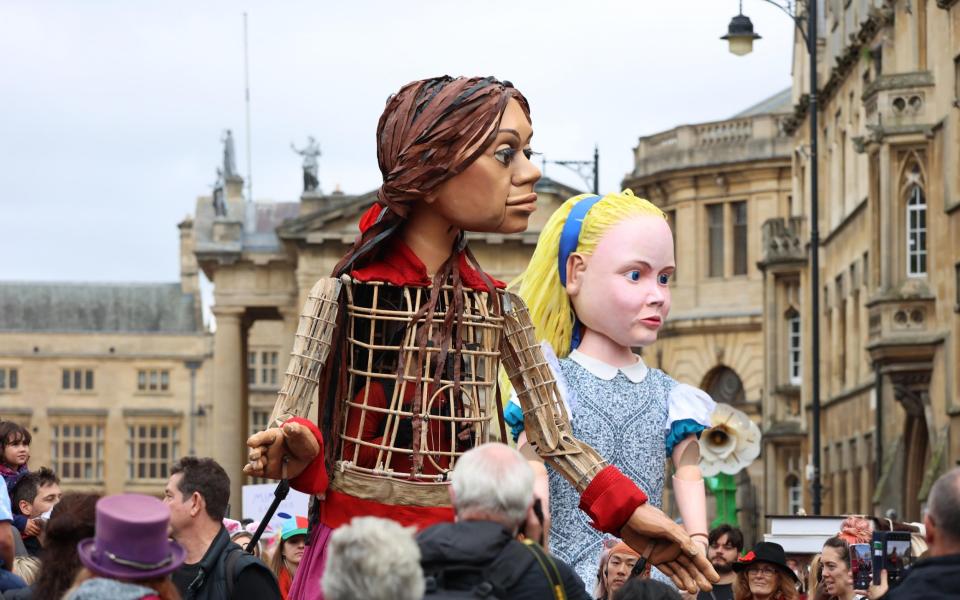The lunacy of Little Amal, the puppet who became a fetish for self-deluding liberals

On January 13, the seventh pro-Palestine march took to the streets of London – this time with a celebrity in tow. Not Jeremy Corbyn, or Susan Sarandon, but four people in a 10-foot puppet of a Syrian child called Little Amal.
Amid SWP placards and Palestinian flags, Amal posed for photos and touched the heads of protesters. It’s not her first rodeo – Little Amal is quite the media operator. Saturday’s appearance was one of many planned by The Walk Productions and Handspring Puppet Company, creators of the puppet. Amal has appeared across the globe, from Brighton and Stone Henge to Gaziantep on the Turkish border and Oaxaca in Mexico.
In the summer of 2021, Amal embarked on a 8,000 kilometer walk from the Turkish-Syrian border to Manchester, looking for her mother “who set out in search of some food and never returned”. The Walk Productions, which produces the performance side of the puppet, describes her tour as “large scale participatory public art” to “challenge assumptions, rethink narratives and provoke change”.
Since its creation in 2015, the giant puppet has become a vessel for all and any liberal cause – hugging attendees at COP conferences and spreading the message of solidarity at The Hague. If you want to know what Little Amal’s politics are, note that she appeared at the Palestine march on Saturday, but was presumably washing her hair for the one in solidarity with Israeli hostages on Sunday. Getting your picture with Little Amal is like donating to Amnesty International – it sends the right kind of signals to the right sections of society.
The puppet’s origins were specific – born as a character in a play set and performed in the Calais Jungle at the time of international debate about the migrant crisis. Fleeing from war and destruction in the Middle East, European ports and cities were filling up with families looking for better lives. The Calais Jungle in particular became a centre of attention, with celebrities like Lily Allen filming themselves crying while visiting children living in makeshift tents and shacks.
The fact that so many children were caught up in the crisis struck a chord with many. That same year, two-year-old Alan Kurdi washed up on a beach, with photos of his lifeless body sparking intensified global outrage about the plight of many Syrian refugees.
But Little Amal doesn’t hang out with kid refugees anymore. These days, her clientele include phone-wielding fans in Coney Island. Puppetry fan Laura Collins-Hughes writing for the New York Times notes Amal’s ability to pose in New York’s most “Instagrammable” neighbourhood, as well as stop for photos ops outside the public library and other landmarks. Outside the Lincoln Center, Collins-Hughes wrote that Amal “seemed more like a dignitary granting an audience than a child ambassador for a cause”. And yet, she notes that “symbolic behavior matters”, that even as a “buzzy spectacle”, Amal is ‘one you want to be able to say you saw’.

In terms of the puppet itself, Amal is technically masterful – a light-weight but giant moving puppet, whose intricate movements seem surprising at such scale. This level of detail and craft is what South African company Handspring Puppet Company is famous for, whose previous puppet for the theatre production War Horse in 2007 won them international fame. Indeed, Little Amal’s public theatre is often accompanied by bands or music. Such is the demand on her calendar that there are actually numerous Amals, with various productions and performances taking place in different locations.
Fans of puppetry will have their own opinions – I’ve always been left cold by street theatre. But perhaps that’s because Little Amal’s performances were never really about art or serious discussions about the migrant crisis, but something liberal and nebulous in between. Back in 2021, the Guardian’s editorial described Little Amal’s art as “acting as society’s conscience”, quoting producer of The Walk Production’s David Lan describing the puppet as “an opportunity for people to be sympathetic and imagine what it would be like to be her”.
Wow, what a magical and moving morning welcoming #LittleAmal to #Lewisham 😍 Thank you for coming out and showing Little Amal that we are a Borough of Sanctuary where refugees are always welcome 👐❤#TheWalk #LittleAmal #LewishamWelcomes pic.twitter.com/yujjHrM0gb
— Lewisham Council (@LewishamCouncil) October 22, 2021
Much was made of the fact that Amal faced a hostile welcome in some countries, with stones and insults thrown at her. But even refusing a selfie with Little Amal is considered non-U. Little Amal may as well be wearing a t-shirt that says “don’t you care?” If Hamlet told us that art functions “to hold, as ‘twere, the mirror up to nature”, Little Amal clunks you round the head with it. This is not art, it’s a black square on your Instagram, a hashtag on your Twitter feed, a mascot for NGO gatherings and international conferences. Little Amal might have begun on the artist’s table, but she has become the cheerleader of the global middle classes.
Exploring political issues through the eyes of a child is nothing new. Mark Twain’s 19th century story of Huckleberry Finn, a young boy living through slavery, opened generations of young reader’s eyes to the horror and injustice of slavery. By putting racial slurs and prejudices into the mouth of a boy – and by drawing on the reality of life under slavery – Twain’s art did indeed provoke discussion about political change.
It is perhaps ironic that, unlike the welcome Little Amal receives, Twain’s teenager is banned from many schools and libraries for being too political. Twain’s pessimistic ending to Huck Finn, coloured by the realisation of how little had changed in the lives of black Americans under Jim Crow rules, has long stuck in the craw of readers. Perhaps if Twain has played it safer, and used his art to tap into the platitudes of liberal consensus, his characters might too be invited to COP conferences.

Little Amal serves as a comfort to the liberal middle classes, who feel that Something Should Be Done about global injustices. Much like the papier-mâché at Extinction Rebellion protests or the die-ins at pro-Palestine marches in train stations, she satisfies the need to make a bit of a show of one’s political leanings. She is safe – who could object to the image of a child? She is secure – who could question a public work of art, international recognised and globally adored?
But the issues Little Amal seeks to be ambassador for are neither safe nor secure. Debates about immigration cannot be boiled down to a simplistic and moralistic challenge about child safety, but must tussle with big issues of democracy, sovereignty and international solidarity. Appearing as an ambassador for Palestinian children at the march on the weekend, one can’t help but wonder why Amal’s creators didn’t want her to represent the Jewish children captured and murdered by Hamas fighters.
This puppet might know her angles in front of a camera, and create a feeling of satisfaction in those for whom politics is a list of boxes to tick, but that’s about it. If we want to have a discussion about the disruption and destruction of the Middle East, let’s not let a puppet pundit distract us from doing just that.

